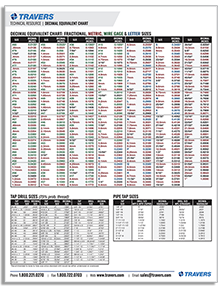Decoding Fractions: Finding Decimal Equivalent Without a Chart
In the meticulous world of metalworking, precision isn't just a goal; it's a necessity. This precision often involves converting fractions to their decimal equivalents, a fundamental skill that's as essential as it is straightforward. Let's jump into the process of how to find an equivalent decimal, and learn an easy way to turn a fraction into a decimal.

Understanding Fractions in Metalworking
First off, let’s remind ourselves what a fraction represents. In the simplest terms, a fraction is a division problem. It's a way to express parts of a whole. In our line of work, fractions are everywhere – from measurements on blueprints to adjustments on machinery, etc.
The Forward Slash: More Than Just a Symbol
In fractions, the forward slash (/) is more than just a separator; it's a division symbol. This is where many of the calculations in metalworking hinge. Recognizing this slash as a sign of division is the first step in translating fractions into decimals.
Divide to Conquer: The Core Principle
To find the decimal equivalent of a fraction, you divide the numerator (the number to the left of the slash) by the denominator (the number on the right of the slash). For example, let's take a common fraction in metalworking: 1/2. This fraction is essentially telling us to divide 1 by 2 (1 ÷ 2). Doing this division gives us 0.5, which is the decimal equivalent of 1/2.
Fractions, like 5/8 or 7/16 work the same way. The same principle applies – divide the top number by the bottom number. For example, for 5/8, 5 divided by 8 is .625, and for 7/16, 7 divided by 16 gives us 0.4375.
Why This Conversion Matters
In metalworking, precision is a top priority. Working with decimals can often be more practical and accurate, especially when dealing with digital measuring tools, computers, or programable machinery. Understanding how to quickly convert fractions to decimals allows for seamless transitions between different measurement systems, ensuring accuracy in every cut. In addition, utilizing these conversions can help you confidently confirm you've selected the appropriate size equivalent of the drill bits, reamers, or taps utilized for your holemaking and threading applications.
Save time & convert sizes AT a glance!
 We've compiled a decimal equivalent chart that includes the most popular fractional, metric, wire gage and letter sizes used in metalworking and holemaking applicatiions. Download the chart and quickly determine the equivalent size of your cutting tools, allowing you to avoid time-consuming math and potential errors.
We've compiled a decimal equivalent chart that includes the most popular fractional, metric, wire gage and letter sizes used in metalworking and holemaking applicatiions. Download the chart and quickly determine the equivalent size of your cutting tools, allowing you to avoid time-consuming math and potential errors.
Our comprehensive decimal equivalent chart lists:
- Fractional Sizes
- Metric Sizes
- Wire Gage Sizes
- Letter Sizes
- Tap & Drill Sizes



